A Ilha de Páscoa e seus misteriosos guardiões de pedra
Fotos: Marjorie Madruga
Para quem gosta de ler e conhecer lugares exóticos e longínquos, a Ilha de Páscoa ou Rapa Nui (nome indígena) é um desses lugares. Ela está situada cerca de 3700 km da costa do Chile, 4200 km do Taiti, com uma área de 16,628 hectares, dos quais 7000 hectares é Patrimônio Mundial.

O Parque Nacional de Rapa Nui cobre 40% da área da ilha, cuja capital é Hanga Roa, aliás, a única cidade da ilha. São três os principais vulcões de Rapa Nui, sendo que o Rano Raraku é o que forneceu toda a pedra necessária para construir as estátuas. A Ilha Rapa Nui é o lugar mais remoto da América do Sul que é habitado.
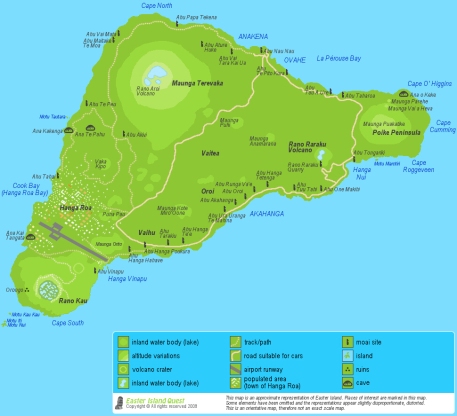

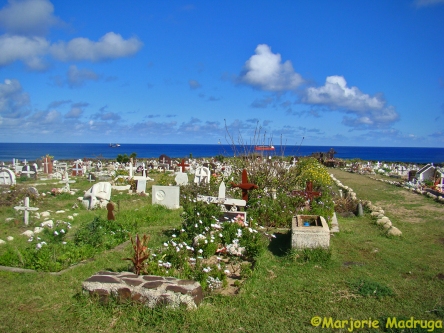
Primeiro, vamos entender um pouco sobre a história do lugar. Essa ilha foi vista pela primeira vez em um Domingo de Páscoa, em 1722, pelo almirante holandês Jacop Roggeveen. Segundo especialistas, os primeiros habitantes da ilha eram oriundos do povo que chegou a Fiji em 1000 a.C. aproximadamente. Os descendentes desses povos chegaram a Ilha de Páscoa por volta de 380 D.C, quando estabeleceram uma tradição de escultura monumental. O mais impressionante é que o que foi produzido lá, foi criado livre de influências externas. Foi entre os séculos X e XVI que essa sociedade construiu santuários e ergueu as colossais figuras de pedra, os moais.
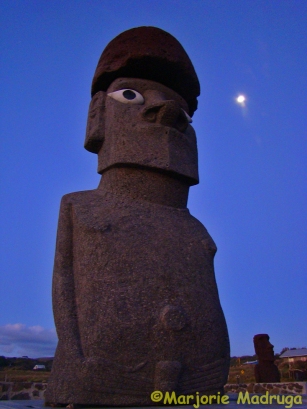
Antes de contarmos sobre as famosas estátuas, é bom que o leitor entenda os seguintes termos: ahu (são plataformas funerárias de pedra, localizados à beira-mar, o maior é o de Vina Pu, na costa sul da ilha) e moai (é nome dado às esculturas de pedra).
Os moais estão espalhados pela ilha, foram descobertos em torno de 900 estátuas, com dimensões variadas, tem moai de 1 metro de altura e outros que ultrapassam os nove metros. Algumas estátuas estão dispostas perto dos ahus, outras estão próximas a uma pedreira em Rano Raraku, o local é conhecido pelo nome de Fábrica dos Moais. Em se tratando dos ahus, cerca de 300 dessas plataformas foram encontradas por lá, a maioria está destruída pela ação dos homens, animais e pelas intempéries. Os principais ahus: Vaihu, Akahanga, Heki’i, Raai, Te Peu e Vinapu. Além das estátuas, você também pode observar restos de assentamentos humanos, áreas de cultivo e cerimonias.Há também outros sítios arqueológicos em forma de cavernas, com arte rupestre.
Voltando a comentar sobre os moais, quando a gente olha para as estátuas e vê aquelas figuras masculinas imensas, com grandes lóbulos auriculares, algumas com corpos decorados, ficamos pensando com que propósito elas foram construídas. Por que a maioria estão de costas para o mar, olhando fixamente para as casas e para os campos? Existem muitas teorias a respeito dessas estátuas, algumas dizem até que elas foram construídas para servirem de para-raios…
Para você ter uma ideia, veja abaixo uma lista com as principais atrações dessa ilha que atrai tantos visitantes:
Vulcão Rano Raraku – conhecido como o passeio à Fábrica de Moais

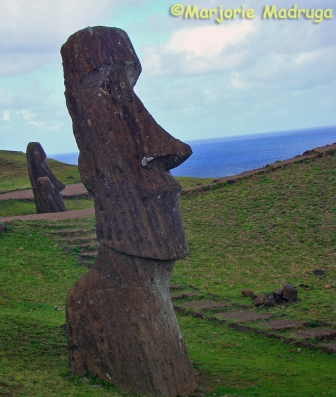
Ahu Mohai –a maioria está destruída pela ação dos homens, animais e pelas intempéries. Os principais: Vaihu, Akahanga, Heki’i, Raai, Te Peu y Vinapu. Além das estátuas, você também pode observar restos de assentamentos humanos, áreas de cultivo e cerimonias
Ahu Tongariki – área restaurada com a plataforma onde estão juntos 15 moais
Complejo Tahai-Ko Te Riku – sítio arqueológico onde é possível ver restos de assentamento humano, além de moais
Ahu Huri a Urenga – área com uma única estátua que está voltada para o nascer do sol
Ahu Akivi – esse sítio conta com 7 estátuas voltadas para poente
Ahu Ature Huki – sítio arqueológico situado na praia de Anakena
Ahu Nau Nau – sítio localizado na praia de Anakena, os moais dessa área são tatuados e usam vestimentas
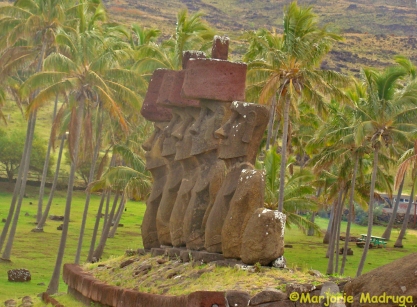
Playa Ovahe – praia ideal para praticar mergulho e nudismo.
Orongo – uma vila de natureza cerimonial. A visita é interessante devido à sua localização e arquitetura.
A Ilha de Páscoa oferece várias opções de passeios: fazer trilha de bicicleta, a pé, a cavalo, ir à praia, apreciar as belas paisagens das ilhas, passeio de barco com mergulho, dentre outros. A gastronomia da ilha atrai quem gosta de peixes, tem um atum grelhado, ceviche.Se você quiser relatos detalhados sobre visitas à ilha, recomendamos que visitem o blog Revivendo viagens e o blog A Mochila e o Mundo.
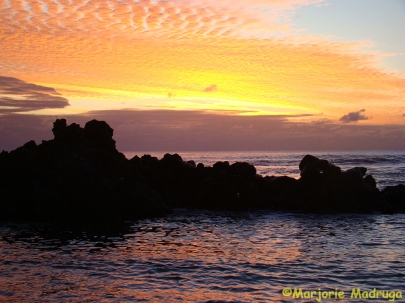
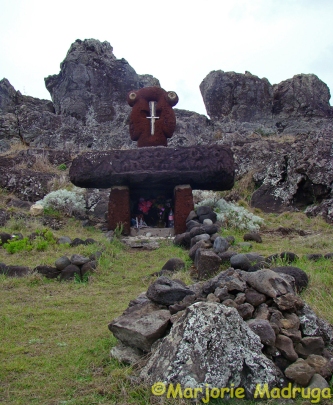
Como chegar lá? Há voos saindo de Santiago e tem a duração de 5 horas e 35 minutos, custa em torno de US$ 1.300,00. Mas, se você ficar de olho, quem sabe consegue comprar o bilhete aéreo quando a LATAM fizer uma promoção…
Se quiser conhecer mais sobre a Ilha de Páscoa, visite os sites seguintes: Portal Rapa Nui e o da UNESCO.
Gostaríamos de agradecer a amiga Marjorie Madruga por ter nos fornecido as belas fotografias que ilustram esse post.
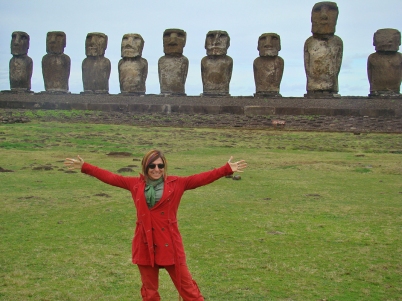
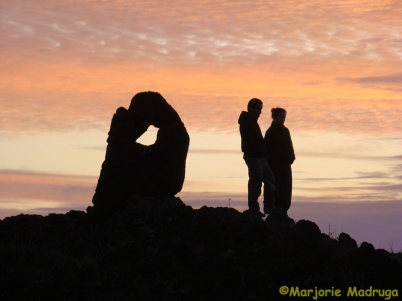
Observação: se você quiser continuar “viajando” com o nosso blog, clique no botão “seguir” localizado no canto inferior direito dessa página. Você receberá um email com um link para confirmar a assinatura desse blog (não paga nada). Quando clicar no link, você será direcionado para uma página em inglês (essa página explica o procedimento no caso de você desejar um dia parar de seguir o blog). A partir daí, você já está “seguindo” o blog.
Die Osterinsel und seine geheimnisvollen steinernen Wächter
Fotos: Marjorie Madruga
Wer gerne über exotische und weit entfernte Orte lesen und lernen möchte für den ist die Osterinsel oder auch Rapa Nui, von den Einheimischen so genannt, einer dieser Orte. Sie ist etwa 3700 km von der Küste Chiles, 4200 km von Tahiti entfernt mit einer Fläche von 16,628 Hektar, wovon 7000 Hektar Weltkulturerbe sind.
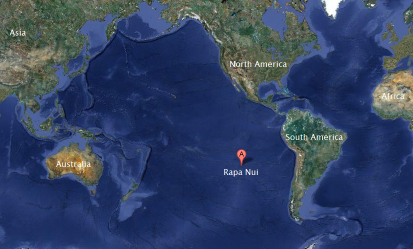
Der Nationalpark Rapa Nui umfasst 40% der Inselfläche mit der Hauptstadt Hanga Roa, die einzige Stadt auf der Insel. Es gibt drei Hauptvulkane auf Rapa Nui wobei es der Rano Raraku ist, der all das Gestein liefert, das für den Bau der Statuen benötigt wird. Die Osterinsel ist der am weitesten von Südamerika entfernte und gleichsam bewohnte Ort.

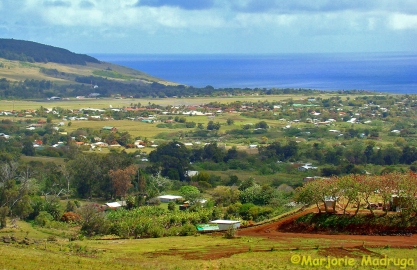

Lassen Sie uns zunächst ein wenig die Geschichte dieses Ortes verstehen lernen. Diese Insel wurde zum ersten Mal im Jahre 1722 vom niederländische Admiral Roggeveen Jacop gesichtet und zwar am Ostersonntag. Nach Einschätzung von Experten kamen die ersten Bewohner der Insel etwa 1000 vor Christus von den Fidschi-Inseln. Die Nachkommen dieser Menschen kamen rund 380 nach Christus auf die Osterinsel und etablierten diese Tradition der monumentalen Skulpturen. Auffällig ist, dass das, was dort produziert wurde, frei von jeglichen äußeren Einflüssen war. Zwischen dem 10. Und 16. Jahrhundert erschuf diese Gesellschaft Schreine und errichtete diese kolossalen Steinfiguren, die Moai.

Bevor wir über die berühmten Statuen sprechen, ist es gut, folgenden Begriffe zu verstehen: ahu (sind Steingrab Plattformen am Meer gelegen, die größte ist die Vina Pu an der Südküste der Insel) und Moai (Name für die Steinskulpturen).
Die Moais sind rund um die Insel verstreut, es wurden um die 900 Statuen entdeckt mit unterschiedlichen Abmessungen. Es gibt Moais mit nur 1 Meter Höhe und andere mit mehr als neun Metern. Einige Statuen befinden sich in der Nähe von „ahus“, andere sind in der Nähe eines Steinbruchs bei Rano Raraku, ein Ort bekannt als Fabrik der Moais. Im Falle der ahus wurden dort etwa 300 dieser Stein-Plattformen gefunden, die meisten waren jedoch durch die Einwirkung von Menschen, Tieren und dem Wetter zerstört. Die wichtigsten ahus: Vaihu, Akahanga, Heki’i, Raai, Peu und Vinapu Te. Neben den Statuen können Sie auch die Reste menschlicher Siedlungen, Acker- und Zeremonienflächen begutachten. Weitere archäologische Stätten existieren in Form von Höhlen mit Felsmalereien. Beim Betrachten dieser riesigen männlichen Figuren, manche dekoriert, mit den groβen Ohrläppchen fragt man sich unweigerlich zu welchem Zweck sie konstruiert wurden. Warum sind sie mit dem Rücken zum Meer mit diesem starren Blick auf die Häuser und Felder? Es gibt viele Theorien über diese Statuen, manche besagen sogar, daβ sie gebaut wurden, um als Blitzableiter zu dienen.
Hier nun eine Liste der wichtigsten Attraktionen dieser Insel, die so viele Besucher magisch anzieht:
Rano Raraku – bekannt als der Ausflug zur Moai-Fabrik
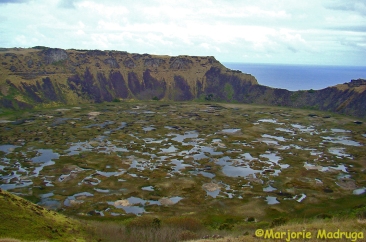

Ahu Mohai – gröβtenteils durch Mensch, Tier und dem Wetter zerstört. Die Haupt Ahus: Vaihu, Akahanga, Heki’i, Raai, Te Peu y Vinapu. Neben den Statuen können auch Reste menschlicher Ansiedlungen, Anbauflächen und Zeremonienstätten begutachtet werden.
Ahu Tongariki – restaurierte Plattform zusammen mit 15 Moais
Complejo Tahai-Ko Te Riku – archäologische Stätte mit Überresten menschlicher Siedlung sowie Moai
Ahu Huri a Urenga – Bereich mit einer einzigen Statue dem Sonnenaufgang zugewandt
Ahu Akivi – 7 Statuen nach Westen ausgerichtet
Ahu Ature Huki – archäologische Stätte am Strand von Anakena gelegen
Ahu Nau Nau – auch direkt am Strand von Anakena gelegen, die Moais tätowiert und tragen Kleider

Playa Ovahe – idealer Strand zum Tauchen und Nudismus
Orongo – ein Dorf von zeremoniellen Natur. Der Besuch ist interessant wegen seiner Lage und Architektur
Die Osterinsel bietet verschiedenste Aktivitäten: Radtouren, wandern, reiten, am Strand spazieren, genießen Sie die schöne Landschaften der Inseln, Bootstouren mit schnorcheln usw. Die Küche der Insel zieht diejenigen an, die Fisch mögen, einen gegrillten Thunfisch z.B. oder
Ceviche. Für detaillierte Berichte über die Insel empfehlen wir den Besuch der Blogs Revivendo viagens und A Mochila e o Mundo.
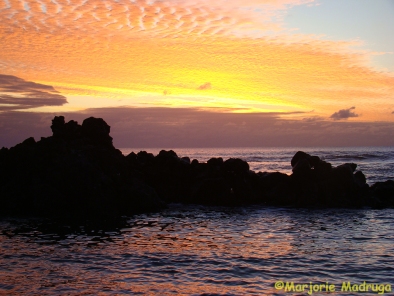

Wie kommt man hin? Es gibt Flüge von Santiago mit einer Dauer von 5 Stunden und 35 Minuten und Kosten von etwa 1.300 US $ . Aber Sie können das Ganze ja ganz einfach im Auge behalten und warten auf eine Werbungsaktion der LATAM.
Falls Sie mehr über die Osterinsel erfahren möchten, besuchen Sie einfach die folgenden Websites: Portal Rapa Nui und die der UNESCO.
Wir möchten an dieser Stelle unserer Freundin Marjorie Madruga danken für die schönen Fotografien, die diesen Beitrag illustrieren.
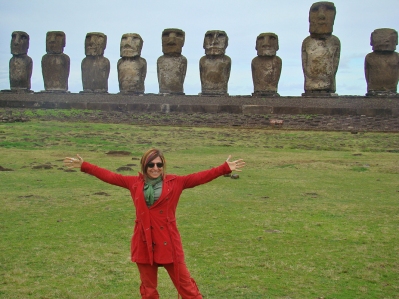

Hinweis: Falls Sie unseren “Reisen” auf dem Blog folgen wollen, dann klicken Sie unten rechts einfach auf “Weiter”, Sie werden dann zukünftig automatisch informiert.
The Easter Island and its mysterious stone guardians
Photos: Marjorie Madruga
If you would like to read and learn about exotic and distant places, the Easter Island, also called Rapa Nui by the locals, is one of these places. It is about 3700 km from the coast of Chile, 4200 km from Tahiti with an area of 16,628 hectares, of which 7000 hectares are world heritage sites.

The National Park Rapa Nui covers 40% of the island with the capital Hanga Roa, the only town on the island. There are three main volcanoes on Rapa Nui, the Rano Raraku is the one which supplied all the rocks needed for the construction of the statues. The Easter Island is the most remote and inhabited place from South America.
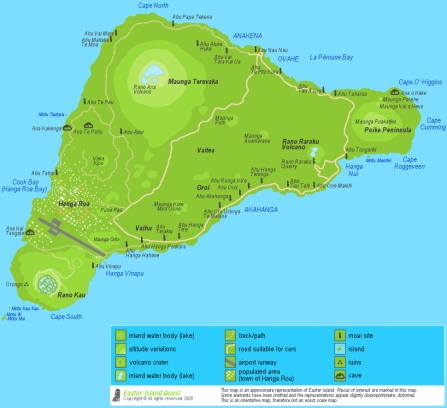


Let us look onto the history of this place. This island was first seen in 1722 by the Dutch Admiral Roggeveen Jacop on the Easter Sunday. According to experts the first inhabitants of the island came from the Fiji Islands about 1000 B.C. The descendants of these people came to the Easter Island around 380 A.D. and established this tradition of monumental sculptures. It is striking that what was produced there was free from any external influences. Between the 10th and 16th centuries this society created shrines and built these colossal stone figures, the Moais.
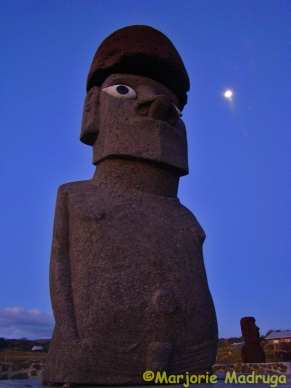
Before talking about the famous statues, it is good to understand the following terms: ahu (are stone grave platforms located close to the sea, the largest is the Vina Pu on the south coast of the island) and Moai (name for the stone sculpture).
The Moais are scattered around the island, around 900 statues have been discovered with different dimensions. There are Moais with only one meter height and others with more than nine meters. Some statues are located near “ahus”, others are near a quarry close to Rano Raraku, a place known as the Moais factory. In the case of the ahus, about 300 of these stone platforms were found there, but most were destroyed by the effects of humans, animals and the weather. The most important ahus: Vaihu, Akahanga, Heki’i, Raai, Peu and Vinapu Te. In addition to the statues you can also examine the remains of human settlements, cultivation and ceremonial areas. Other archaeological sites exist in form of caves with Rock paintings. Looking at these huge male figures, some decorated and with the big earlobes, you inevitably ask youself what purpose they were designed for. Why do most of them have their backs to the sea, staring at the houses and the fields? There are many theories about these statues, some even say they were built to serve as lightning rod.
Here is a list of the main attractions on the island, which attracts so many visitors magically:
Rano Raraku – known as the Moai factory


Ahu Mohai – largely destroyed by humans, animals and the weather. The main ahus: Vaihu, Akahanga, Heki’i, Raai, Te Peu y Vinapu. In addition to the statues the remains of human settlements, cultivation areas and ceremonial services can also be examined.
Ahu Tongariki – restored platform together with 15 Moais
Complejo Tahai-Ko Te Riku – archaeological site with remains of human settlement as well as Moais
Ahu Huri a Urenga – area with a single statue facing the sunrise
Ahu Akivi – 7 statues aligned to the west
Ahu Ature Huki – archaeological site located at the beach of Anakena
Ahu Nau Nau – also located directly at the beach of Anakena with Moais tattooed and wearing clothes

Playa Ovahe – beach for diving and nudism
Orongo – a village of ceremonial nature. The visit is interesting because of its location and architecture
The island offers a variety of activities: cycling, hiking, horseback riding, walking alongside the beach, enjoying the beautiful landscapes of the islands, boat trips with snorkeling, etc. The island’s cuisine attracts those who like fish, for example grilled tuna or Ceviche. For detailed reports about the island we recommend visiting the Blog Revivendo Viagens and the Blog A Mochila e o Mundo.
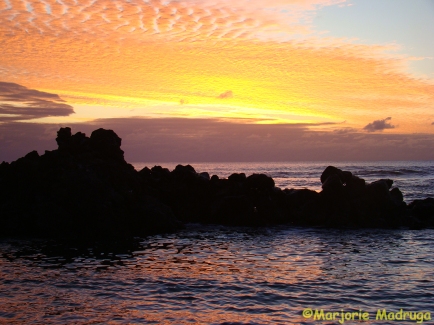

How to get there? There are flights from Santiago with a duration of 5 hours and 35 minutes and costs around US $ 1,300.00. But you can keep an eye on the whole thing and just wait for a LATAM advertising campaign.
If you would like to know more about the Island simply visit the following websites: Portal Rapa Nui and the UNESCO website.
We would like to thank our friend Marjorie Madruga for the beautiful photographs that illustrate this article.
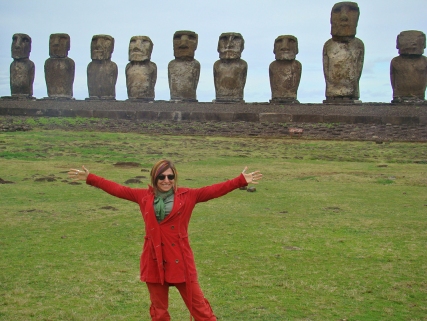
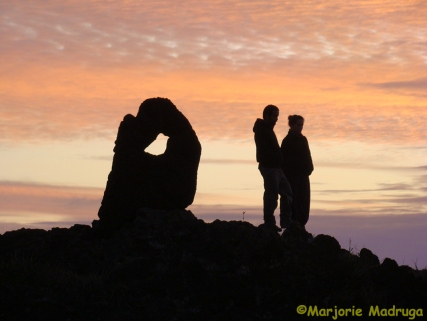
Note: If you want to follow our “Journeys” on the blog, simply click on “Continue” in the lower right corner, you will be automatically informed in the future.


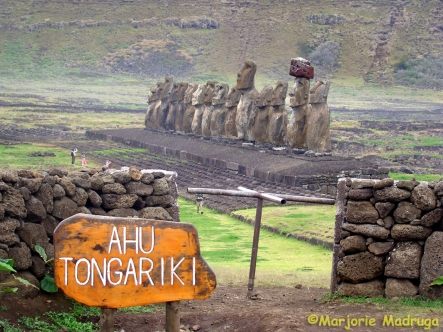


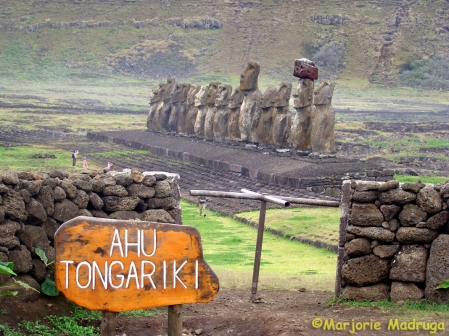




Olá , eu sou Francisco Soares , Engenheiro Eletricista/UFMA e Mestre em Energia e Ambiente/UFMA/BR)
Sou autor do Livro : ” Os Para Raios de Pedra da Ilha de Páscoa ” EDFMA :1994
Estou disposto a falar do assunto / 55 (098) 99971 1027
CurtirCurtir
Olá Francisco, que prazer ver seu comentário no nosso blog, nós agradecemos pela sua visita e também por se colocar a disposição para tratar sobre o assunto.Li sobre seu trabalho na Internet, parabéns!
CurtirCurtir
Será um prazer contribuir com o tema. Parabens pela materia
CurtirCurtir
Olá Francisco, agradecemos sua visita e sua disponibilidade em contribuir sobre o tema. Abraços! Volte sempre ao nosso blog!
CurtirCurtir